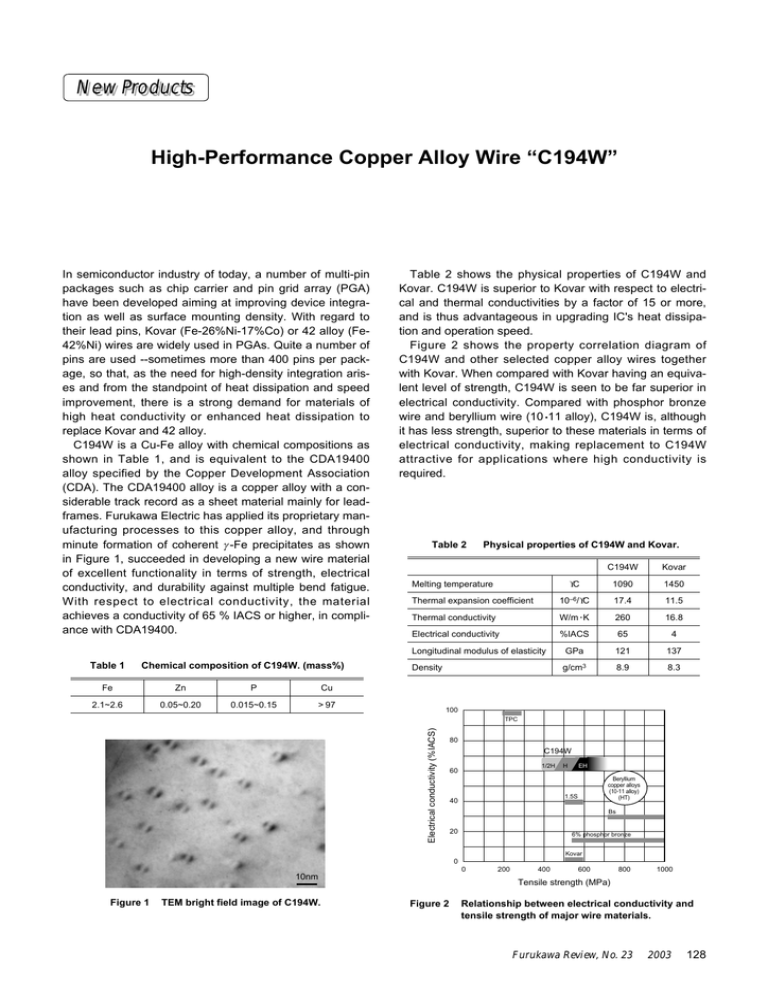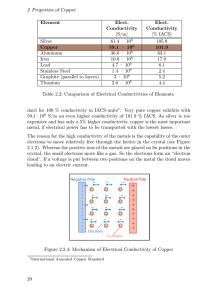High-Performance Copper Alloy Wire “C194W” New Products
advertisement

New New Products Products High-Performance Copper Alloy Wire “C194W” In semiconductor industry of today, a number of multi-pin packages such as chip carrier and pin grid array (PGA) have been developed aiming at improving device integration as well as surface mounting density. With regard to their lead pins, Kovar (Fe-26%Ni-17%Co) or 42 alloy (Fe42%Ni) wires are widely used in PGAs. Quite a number of pins are used --sometimes more than 400 pins per package, so that, as the need for high-density integration arises and from the standpoint of heat dissipation and speed improvement, there is a strong demand for materials of high heat conductivity or enhanced heat dissipation to replace Kovar and 42 alloy. C194W is a Cu-Fe alloy with chemical compositions as shown in Table 1, and is equivalent to the CDA19400 alloy specified by the Copper Development Association (CDA). The CDA19400 alloy is a copper alloy with a considerable track record as a sheet material mainly for leadframes. Furukawa Electric has applied its proprietary manufacturing processes to this copper alloy, and through minute formation of coherent γ -Fe precipitates as shown in Figure 1, succeeded in developing a new wire material of excellent functionality in terms of strength, electrical conductivity, and durability against multiple bend fatigue. With respect to electrical conductivity, the material achieves a conductivity of 65 % IACS or higher, in compliance with CDA19400. Table 1 Chemical composition of C194W. (mass%) Fe Zn P Cu 2.1~2.6 0.05~0.20 0.015~0.15 > 97 Table 2 shows the physical properties of C194W and Kovar. C194W is superior to Kovar with respect to electrical and thermal conductivities by a factor of 15 or more, and is thus advantageous in upgrading IC's heat dissipation and operation speed. Figure 2 shows the property correlation diagram of C194W and other selected copper alloy wires together with Kovar. When compared with Kovar having an equivalent level of strength, C194W is seen to be far superior in electrical conductivity. Compared with phosphor bronze wire and beryllium wire (10 •11 alloy), C194W is, although it has less strength, superior to these materials in terms of electrical conductivity, making replacement to C194W attractive for applications where high conductivity is required. Table 2 Physical properties of C194W and Kovar. C194W Kovar °C 1090 1450 Thermal expansion coefficient 10–6/°C 17.4 11.5 Thermal conductivity W/m • K 260 16.8 Electrical conductivity %IACS 65 4 Longitudinal modulus of elasticity GPa 121 137 Density g/cm3 8.9 8.3 Melting temperature 100 Electrical conductivity (%IACS) TPC 80 C194W 1/2H 60 H EH Beryllium copper alloys (10 •11 alloy) (HT) 1.5S 40 Bs 20 6% phosphor bronze Kovar 0 0 10nm Figure 1 TEM bright field image of C194W. 200 400 600 800 1000 Tensile strength (MPa) Figure 2 Relationship between electrical conductivity and tensile strength of major wire materials. Furukawa Review, No. 23 2003 128 High-Performance Copper Alloy Wire “C194W” Table 3 Standard specifications of C194W. Temper Tensile strength MPa EH 410~480 455~520 ≥ 520 % ≤5 ≤2 — Vickers hardness Hv 125~148 135~155 ≥ 150 %IACS ≥ 65 ≥ 65 ≥ 60 100µm Table 4 H Elongation Electrical conductivity Figure 3 1/2H SEM image of bent sample. Typical product sizes and dimensional tolerance of C194W. Wire diameter (mm) Dimensional tolerance (mm) 0.2~0.99 ±0.01 Round wire 1.0~2.99 ±0.02 3.0~4.0 ±0.03 Square wire 0.35~1.15 ±0.05 Table 3 shows the standard specifications of C194W, where three tempers are available: 1/2H, H, and EH. The half-softening temperature for the H temper is 320°C or higher, thereby ensuring sufficient heat resistance in practical applications. Figure 3 shows the SEM image of a bent sample of C194W (H temper, φ 0.45 mm) with bending conditions of : 90° W bend with a bending radius of R = 0 (R/d = 0, where d is wire diameter). No cracking occurred demonstrating excellent bending formability. Table 4 shows typical product sizes of C194W. Wires with a diameter between 0.2 mm and 4.0 mm are available. Moreover, not only round wires but also square wires are available, the selected cross section of which is shown in Figure 4. In addition, plated wires are also available. Currently, C194W is widely used as PGA lead pins for personal computers, and square wires with reflow tin plating have been adopted in connector terminals for automobiles. For more information, please contact: First Marketing Dept., Metals Group TEL: +81-3-3586-3850 FAX: +81-3-3586-3663 200µm a) Round wire Figure 4 b) Square wire Cross sectional views of C194W. Furukawa Review, No. 23 2003 129



